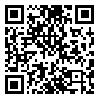Tue, Dec 2, 2025
[Archive]
Volume 22, Issue 1 (March 2025)
IJMSE 2025, 22(1): 1-10 |
Back to browse issues page
Download citation:
BibTeX | RIS | EndNote | Medlars | ProCite | Reference Manager | RefWorks
Send citation to:



BibTeX | RIS | EndNote | Medlars | ProCite | Reference Manager | RefWorks
Send citation to:
Sharma R C. Investigating Electrical and Ferroelectric Properties of Nd Doped BiFeO3-PbTiO3 Solid Solutions. IJMSE 2025; 22 (1) :1-10
URL: http://ijmse.iust.ac.ir/article-1-3744-en.html
URL: http://ijmse.iust.ac.ir/article-1-3744-en.html
Abstract: (11137 Views)
The effect of different Nd and PT compositions on the electrical and ferroelectric properties of (1-y)Bi1-xNdxFeO3-yPbTiO3 solid solutions, where x = 0.05, 0.10, 0.15, 0.20 and y = 0.1, 0.2, 0.3, and 0.4, was investigated to optimise material performance. Nd doping enhances the frequency-dependent dielectric properties of produced solid solutions. However, an anomaly in the dielectric loss tangent, which is consistent with the Debye relaxation process, is observed for compositions with x˂0.10 and y≥0.2 values in the frequency range of 1 KHz to 1 MHz. Dielectric anomalies were more noticeable around the transition temperature in temperature-dependent dielectric characteristics plots, suggesting stronger magnetoelectric interactions. The decrease in the dielectric constant for solid solution compositions with y ≥0.3 indicates the presence of MPB with BFO due to an increase in the tetragonal phase of the PbTiO3 compound. As Nd content increases, temperature-dependent dielectric permittivity predicts relaxor-type ferroelectric performance for y=0.4 composition of solid solutions. A ferroelectric investigation showed that saturation polarisation, remnant polarisation, and coercive field of all prepared solid solutions decrease with increased Nd doping. However, for y˃0.3 composition, a substantial rise in these parameters was observed, which is a result of electric order dominating over magnetic order in solid solutions. The study reveals that Nd doping reduces leakage current, making it a promising contender for future applications
Type of Study: Research Paper |
Send email to the article author
| Rights and permissions | |
 |
This work is licensed under a Creative Commons Attribution-NonCommercial 4.0 International License. |








